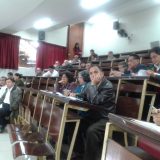1. Problem Analysis and Solution Identification
Analyze a complex computing problem and apply principles of computing and other relevant disciplines to identify solutions.
| Criteria |
| Identify and formulate complex problems, analyze their background, and diagnose their situation and state. |
| Identify conflicting technical and non-technical issues, range of contexts and disciplines, or diversity of interests affecting complex computing problems. |
| Propose, analyze and compare practical and realizable solutions considering their trade-offs, benefits and drawbacks. |
| Evaluate and select the proper solution with technical, sustainability and economic rationality criteria. |
| Correctly apply the methods and techniques of computer science and related disciplines, for the formulation, analysis and description of solutions. |
2. Solutions Design, Implementation and Evaluation
Design, implement, and evaluate a computing-based solution to meet a given set of computing requirements in the context of the program’s discipline.
| Criteria |
| Interpret requirements and needs and translate them into the formulation of a computer science project. |
| Formulate the specifications of a design project considering technical variables, as well as applicable economic, social, and legal restrictions. |
| Propose and evaluate solution alternatives to select the most adequate satisfying requirements and constraints. |
| Apply proper methods, techniques, norms and standards for developing, implementing and evaluating computing-based secure solutions. |
| Integrate software and hardware components optimizing the demand for resources, as well as the robustness and efficiency of the complete solution. |
| Present and describe the solution through specifications, maps, graphs, drawings, diagrams and virtual simulations. |
3. Effective Communication
Communicate effectively in a variety of professional contexts.
| Criteria |
| Express their ideas clearly and concisely pointing to effectively convince technical and non-technical audiences. |
| Elaborate clear and precise technical documentation using norms, symbology and terminology proper of the application field. |
| Adjust their speech according to the audience and context for getting a proper understanding and interpretation. |
| Use proper technological support according to the communication environment. |
| Read technical documentation in English. |
4. Ethics and Responsibility
Recognize professional responsibilities and make informed judgments in computing practice based on legal and ethical principles.
| Criteria |
| Get informed about the background of a problem or ethical situation, and analyze them to issue a fair and proper judgment. |
| Anticipate the implications of their decisions, as well as the results of their actions and projects. |
| Appraise the punctual and responsible fulfillment of their personal and professional duties. |
| Take into consideration community interests and the social benefit. |
| Respect intellectual property and recognizes the authorship of other people works and projects. |
| Know and act according to the professional code of ethics. |
5. Teamworking
Function effectively as a member or leader of a team engaged in activities appropriate to the program’s discipline.
| Criteria |
| Can perform as leader or active member of a working team effectively participating to achieve the proposed goals and outcomes. |
| Propose and accepts ideas conducting to the achievement of objectives and results. |
| Appraise the differences of opinion, is tolerant and respect agreements. |
6. Theoretical-Support Based Solutions
Apply computer science theory and software development fundamentals to produce computing-based solutions.
| Criteria |
| Understand the theoretical foundations of the different areas of computer science and integrates them to produce efficient and quality solutions. |
| Understand the fundamentals and stages of software development and applies them to produce orderly and structured solutions. |
| Correctly apply the concepts and methods of mathematics and science to develop models for analyzing and predicting the behavior of systems. |
| Formulates algorithms, defines data structures and develops programs using the methods and techniques of computer science. |
| Use the methods, techniques and tools of computer science for the formulation, description and solution of problems. |
| Optimize the demand for resources, as well as the robustness and efficiency of the complete solution. |
7. Computer Science Impact
Understand the impact of computer science solutions on people, society and environment in local and global contexts.
| Criteria |
| Recognize the role of computer science on the progress of society and the wellbeing of people. |
| Identify and appraise the economic and social benefits of computer science works and methods. |
| Recognize the importance of computer science for the creation and innovation of products and processes. |
| Understand the role of computer science in risk prevention and disaster mitigation. |

 Download
Download








